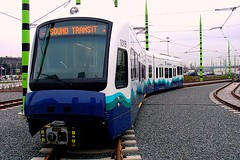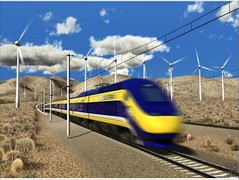Transit comes up a winner at the ballot box (mostly)

Posted November 11, 2008 at 1:33PM
In addition to choosing our leaders for the next administration and Congress, along with state and local offices, voters last week in many cases also decided referenda and ballot initiatives, many of them having a direct bearing on smart growth and sustainable development. Having reviewed the ones that have come across my own computer screen, I can say that last week's election was a very good one for public transportation.
 Voters in and around Seattle approved a half-cent increase in the sales tax to fund $22.8 billion worth of transit expansions championed chiefly by Seattle mayor Greg Nichols. In particular, the money will be used to improve commuter rail and bus service and to add 34 miles to the region's light rail system. Voters had rejected a package only a year ago that included the transit funding but also funding for highway expansion. Seattle voters this year rejected a measure that would allow solo drivers to use HOV lanes during off-peak hours.
Voters in and around Seattle approved a half-cent increase in the sales tax to fund $22.8 billion worth of transit expansions championed chiefly by Seattle mayor Greg Nichols. In particular, the money will be used to improve commuter rail and bus service and to add 34 miles to the region's light rail system. Voters had rejected a package only a year ago that included the transit funding but also funding for highway expansion. Seattle voters this year rejected a measure that would allow solo drivers to use HOV lanes during off-peak hours.
In Honolulu, residents voted to approve a 20-mile elevated steel-rail transit system from Kapolei to Ala Moana. The system will become the single-largest public works project in state history.
Transit was also a big winner in California, where voters statewide narrowly approved the sale of nearly $10 billion in bonds as a down payment on an 800-mile high-speed rail network that would send electric trains zipping between Northern and Southern California at up to 220 mph. The first phase of the massive project, which will also require federal and private investment, will enable planning for the establishment of service that will allow passengers to travel between Los Angeles and San Francisco  in only two and a half hours. The full network would also link those two cities with San Diego, Sacramento, and Riverside County.
in only two and a half hours. The full network would also link those two cities with San Diego, Sacramento, and Riverside County.
Local and regional ballot successes in California included the following:
- Los Angeles voters narrowly achieved the two-thirds supermajority required for approval of Measure R, which authorizes a half-cent sales tax increase to fund the "Subway to the Sea" between Culver City and Santa Monica.
- Sonoma and Marin County voters approved a quarter-cent hike in the sales tax to finance a 70-mile commuter rail line and an adjacent bike and pedestrian path linking the two jurisdictions.
- Voters approved a sales tax increase for a streetcar in West Sacramento.
- Voters approved a modest excise tax increase to support bus service in Alameda County.
- Berkeley voters rejected a measure that would have prohibited dedicating a traffic lane to a bus rapid transit line.
The news wasn't all good, though: In Kansas City, voters rejected a 3/8-cent sales tax to fund a 14-mile light rail line. This was especially disappointing given that voters had approved a similar plan only two years ago but that ultimately proved unworkable. This time, the measure was hurt by the economy and by vagueness in the route, according to a story in the Kansas City Star. A neighboring jurisdiction approved a measure to fund its portion of the line, but that plan will be rescinded in light of the Kansas City vote.
In addition, San Francisco voters rejected Measure B, which would have required that a fixed portion of property taxes be earmarked for affordable housing. California  development pundit Bill Fulton has an extensive list of local measures and their results, most of which appear to me to be locality-specific and mixed in their effect. I was glad to see restrictions on development of steep slopes in some jurisdictions and the passage of several open space measures, along with protection for agricultural land in Napa Valley. Most threatening to smart growth projects may be Redondo Beach's adoption of a requirement for voter approval of any project larger than 25 units or denser than 8.8 units per acre.
development pundit Bill Fulton has an extensive list of local measures and their results, most of which appear to me to be locality-specific and mixed in their effect. I was glad to see restrictions on development of steep slopes in some jurisdictions and the passage of several open space measures, along with protection for agricultural land in Napa Valley. Most threatening to smart growth projects may be Redondo Beach's adoption of a requirement for voter approval of any project larger than 25 units or denser than 8.8 units per acre.
I'm sure there are many more measures with impacts on these issues in other parts of the country. Please leave a comment for readers if you know of one.